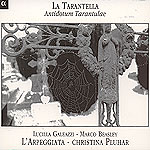As legend has it, the folk dance known as a tarantella originated as the primary cure after being bitten by the notorious tarantula spider–named because of its profusion near the southern Italian city of Taranto. By dancing the tarantella (at times accompanied by chanting, ritual dress, dietetic potions, and alcohol) often for hours and gradually increasing in speed, one supposedly could sweat out the venom from one’s body, suffering hallucinogenic and convulsive fits though avoiding death. Unlike Gregorio Paniagua and the Atrium Musicae Madrid, whose legendary compilation of tarantellas for Harmonia Mundi (recorded more than 25 years ago and still available!) included only one song among its many diverse instrumental arrangements, director Christina Pluhar and the European multi-national ensemble L’Arpeggiata instead focus mainly on the sung texts that draw on the legend. Though there is little reference in the texts to the tarantula itself, the words amply convey aspects of the symptomatic melancholy, anguish, madness, lunacy, and depravation characteristic of the dance’s “cure” and effects.
For example, Luna Lunedda (Moon, little moon) is a lively duet featuring Marco Beasley and Alfio Antico set to a simple yet mesmerizing rhythm of guitar and percussion. As the song progresses Beasley and Antico occasionally begin to wail and shout while offering asides that depart from the mad stream-of-consciousness text–which evolves from wondering how much bread and wine will nourish the Moon to determining how much seven women are worth (a penny, a peach, a walnut, or a snake) before debating whether or not Madame’s daughter could help with the crowing cock beneath master Anthony’s bed. Lu povero ‘Ntonuccio (Little Anthony, poor thing) is an equally compelling and remarkably convincing tale of dread. Here, Anthony’s sweetheart brings his unwitting mother to his ailing side only to discover that it’s too late and he’s already dead. During the song’s finale Lucilla Galeazzi’s grief-stricken howls and screams become so fanatical (and hoarse) that you’d think she was the one about to die.
Alpha’s beautifully designed digipac presentation and richly detailed, acoustically transparent sonics are stunning. Pluhar, Beasley, and Jean-Paul Combet’s informative and entertaining notes are a joy to read, and a model of how to interest novices in exploring more offbeat repertoire such as this. In sum, L’Arpeggiata’s very special program will reward all early music fans, and curious others are encouraged to give this one a listen as well. Highly recommended. [5/19/2004]
































